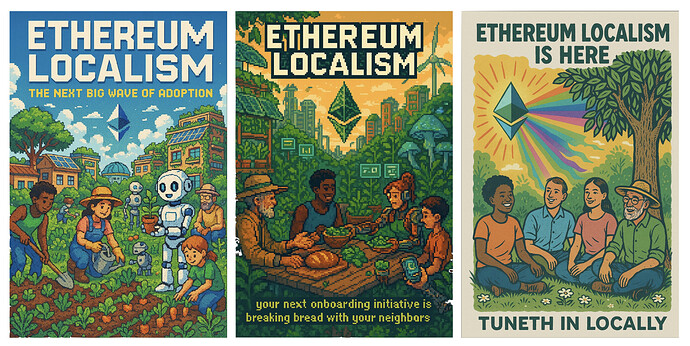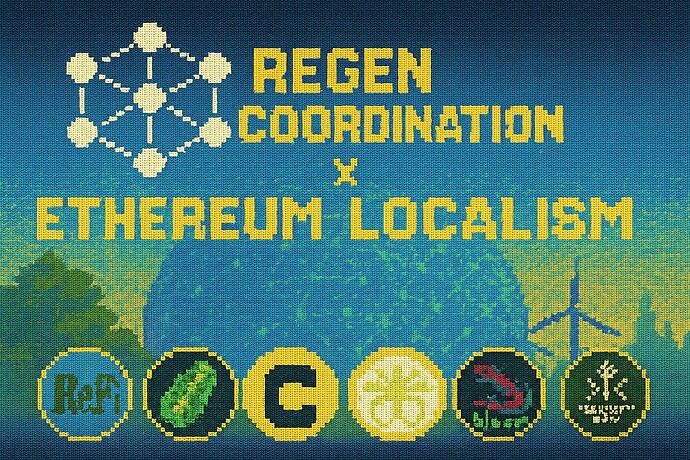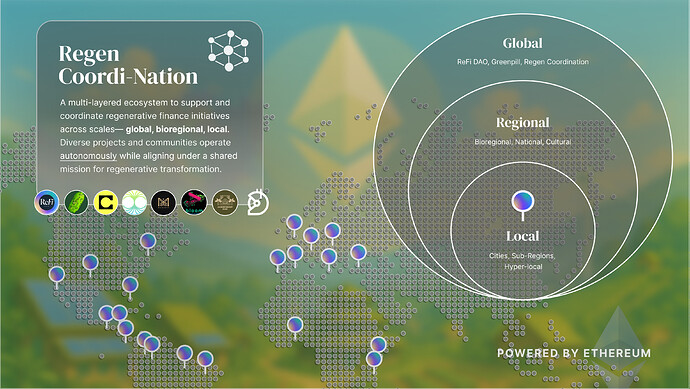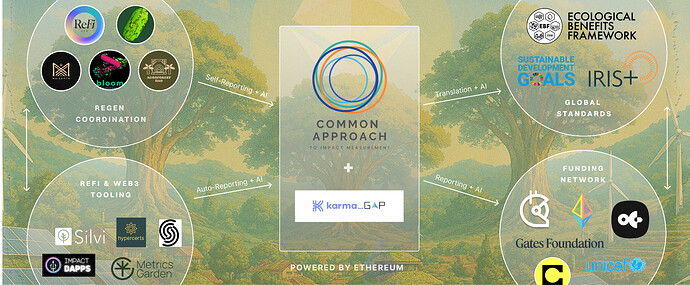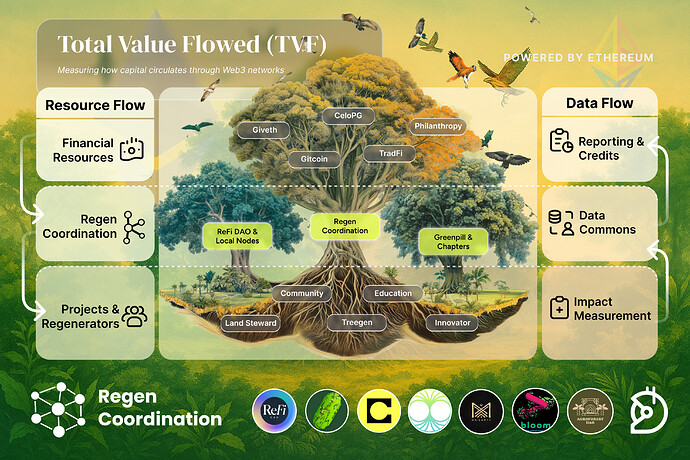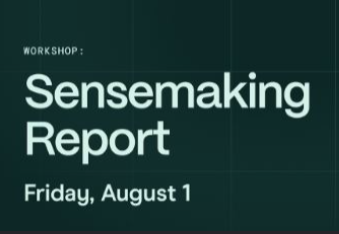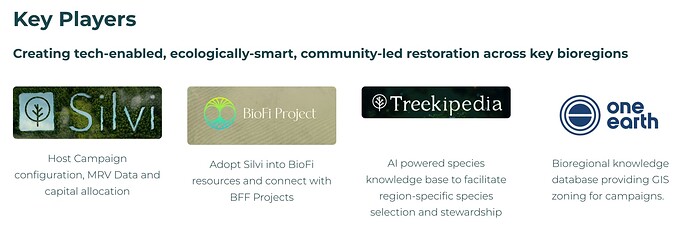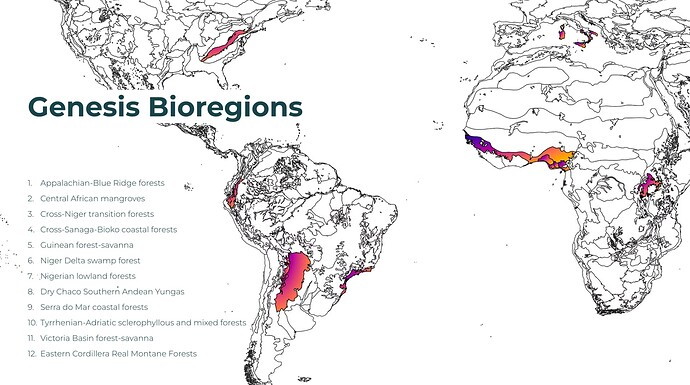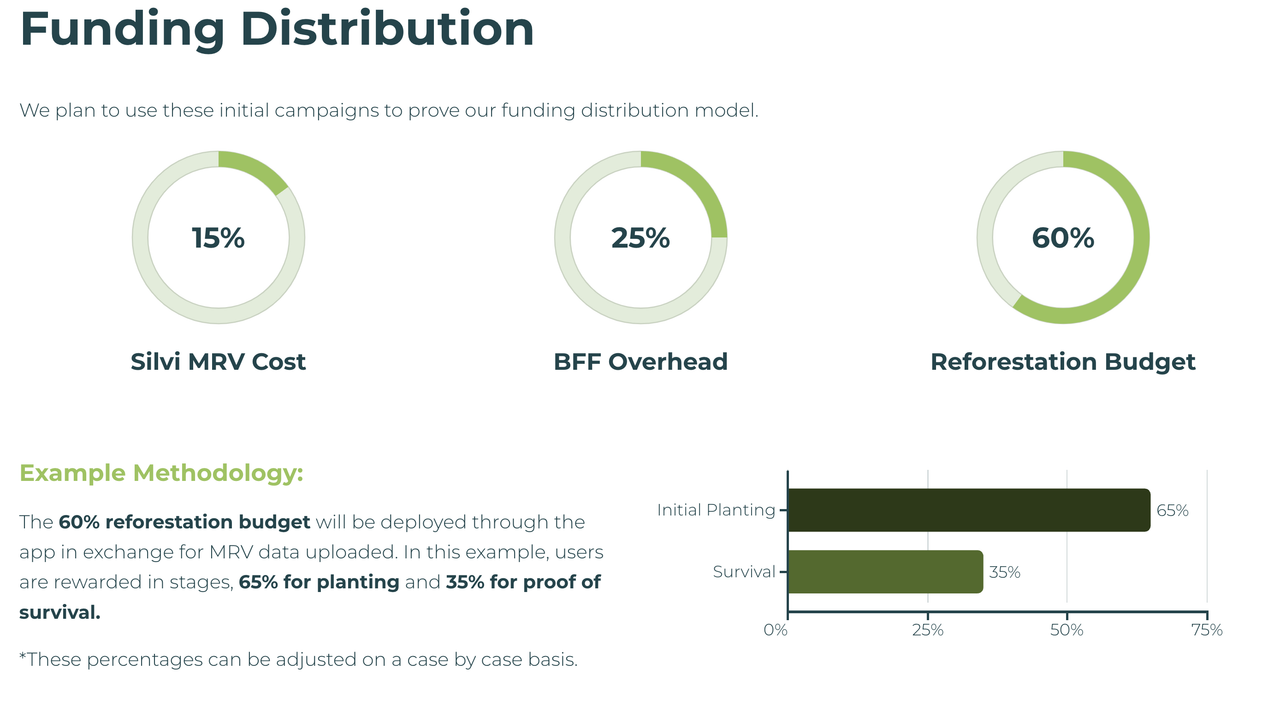TLDR
-
Ethereum Localism is an emerging opportunity space that can address meaningful mass adoption by embedding Web3 tools (e.g., stablecoins, payments, onchain governance) into local communities and economies—offering real-world legitimacy and utility beyond speculation, and aligning with Gitcoin’s mission.
-
Convened by Regen Coordination, this sensemaking report explores the Ethereum Localism landscape, how it is taking shape, and how Gitcoin could play a catalytic role.
-
Following subsequent guidance from Gitcoin, we propose a co-design process to collaboratively launch an Ethereum Localism DDA for GG24 and beyond — in alignment with the Credible Neutrality in Dedicated Domain Allocation research.
Overview
This sensemaking report explores Ethereum Localism as a high-leverage opportunity space for Gitcoin 3.0—one that can help Ethereum address core challenges such as durable and meaningful adoption, post-speculative utility, relevance beyond crypto-native circles, and real-world legitimacy. Ethereum Localism offers a strategic pathway for addressing these challenges by aiming to embed Ethereum infrastructure into the fabric of local communities and economies across the globe.
The report explores how grassroots adoption, institutional interest, and ecosystem maturity are converging—creating a timely opening for Ethereum Localism to scale. It is written from the perspective of Regen Coordination, a collaborative network of organizations stewarding regenerative public goods funding and local ecosystem development across the Web3 space. Over the past year, Regen Coordination has supported local, bioregional, and global funding rounds—including BioFi Pathfinders, ReFi Mediterranean, Regen Rio de Janeiro, Regen Coordination Global, and more—collectively raising and distributing over $370,000 to grassroots projects. Through these efforts, we’ve helped communities use blockchain infrastructure to coordinate capital, measure impact, and build regenerative economies onchain.
Following this sensemaking report, we propose a co-design process with Gitcoin, OpenCivics and other key relevant partners to scope a Dedicated Domain for Ethereum Localism. Regen Coordination would serve as a core founding partner (in alignment with Benjamin Life’s emerging DDA framework) with an intention to support 3–5 local pilots during GG24, pilot new methodologies (e.g. Karma GAP + Prosperity Pass + TVF), and building toward a systematized and scalable model for 10+ rounds in 2026.
Problem & Impact
Ethereum Localism
Ethereum Localism is an emerging opportunity space that speaks directly to one of Ethereum’s most significant long-term challenges: achieving meaningful mass adoption. If Ethereum is to fulfill its promise as a global coordination layer, it must move beyond short-term cycles of speculative hype toward deep, systemic integration into the real-world systems that shape people’s daily lives.
Ethereum Localism emphasizes the importance of place, community, and local context as essential complements to global applications and knowledge. It recognizes that while Ethereum connects us digitally, our material lives remain rooted in local neighborhoods, municipalities, and bioregions. By embedding Ethereum-powered infrastructure into local communities and economies, we can create lasting and meaningful adoption.
This strategy drives adoption on two critical fronts:
-
Infrastructural Integration: Communities and local economies integrate Ethereum-based tools with place-based practices for coordination, governance, and resource stewardship. Rather than introducing speculative or disruptive technologies, digital infrastructure is embedded in ways that enhance transparency, trust, and mutual accountability—creating enduring, context-driven utility rooted in lived relationships.
-
Financial Integration: Communities embed onchain financial tools—including stablecoins, local payment systems, DeFi mechanisms, community grants, and impact credits—into existing formal and informal economic and social systems. This strengthens local economic resilience while creating practical onramps for broader participation and increased onchain capital flows.
Each unique implementation contributes to a growing library of documented open-source blueprints — a global knowledge commons of real-world-tested models that other communities can adapt, remix, and localize to their own needs.
Why is this urgent and significant right now?
The urgency for Ethereum Localism is driven by a convergence of macro trends creating a unique opening for localism. We are witnessing the increasing fragility of globalized systems—supply chain disruptions, economic volatility, climate breakdown, and the deep consolidation of power and wealth. Widespread austerity and shifting public service models are further exposing cracks in current systems, highlighting the need for resilient, cosmo-local driven alternatives.
Meanwhile, Ethereum itself is more ready than ever for mainstream adoption. UX and onboarding hurdles are rapidly being overcome, with low-cost L2s and highly usable “Web 2.5” applications now widely available. The critical bottleneck has become the availability of usable real-world use cases with clear product-market fit. Ethereum Localism offers a path to discover and scale these use cases, embedding blockchain-based apps and infrastructure into the daily operations of communities and economies worldwide.
Crucially, this approach challenges the public perception that Web3 is only useful for speculation. It shows how Ethereum can empower communities to govern and finance what matters—especially in the face of escalating ecological, social, and economic breakdown. In doing so, Ethereum Localism becomes a vehicle for addressing what many now recognize as the metacrisis: a convergence of global challenges that demand coordinated local action at scale.
What evidence supports the importance of this space?
1. Explosive Growth in Localised Web3 Adoption
As of April 2025, Celo’s MiniPay wallet has surpassed 7 million wallet activations across over 50 countries worldwide and with seamless on/off-ramps in 35+ local currencies (Celo Forum, Q4 2024). In Africa, Celo’s regional DAOs and partners have onboarded thousands of developers and community members, with local stablecoins (like cUSD, cKES, cGHC) and payment solutions filling gaps left by traditional financial institutions (Celo Africa DAO Q1 2025). In South America, Communities like ReFi Medellin, Celo Colombia, and Regen Rio are pioneering the adoption of $cCOP (onchain Colombian Peso) and $cREAL (onchain Brazilian Real) as well as developing localized payment solutions and onboarding local people, organizations, and merchants—realizing the vision of bringing entire local economies onchain.
This rapid adoption of Web3 technologies —especially across emerging and underserved markets—demonstrates both the scale of the opportunity and the urgency of the problem Ethereum Localism aims to solve. According to the World Bank, over 1.4 billion adults globally remain unbanked. Web3 solutions can onboard users who have never had access to traditional banking, providing them with digital identity, savings, and credit for the first time.
2. Grassroots ecosystem growth + demonstrated funder interest
The growth of ReFi local nodes, Greenpill Chapters, local hackathons, university blockchain clubs, regional DAOs and many other locally focused grassroots web3 projects, demonstrates a bottom-up demand for building and using Web3 tools tailored to local needs. These projects generate not just user adoption, but ecosystem-building, capacity development, and local leadership.
This momentum is matched by significant funder interest with Regen Coordination supported local, bioregional and global funding rounds (e.g., Regen Coordination, BioFi Pathfinders, ReFi Mediterranean, Rio de Janeiro, Web3 For Universities) having raised over $370,000 to projects in the past year, with thousands of unique donors participating.
3. Local Government and Institutional Interest
Communities are beginning to experiment with blending crypto capital with local philanthropic, cooperative, and municipal funding pools. For example, Zazelenimo’s pilot for urban greening in Split, Croatia, uses a 3:1 municipal matching model to fund community-driven projects with Ethereum-aligned infrastructure. Kesennuma Hackathon in Japan is running a Civic Tech hackathon in collaboration with the local government to build solutions that better serve the local community and with a goal to bring tax dollars onchain.
If either of the above two pilots are successful, they serve as models that can be adapted globally. Global municipal budgets represent an estimated $6 trillion in annual spending yet still rely on 20th-century rails. By providing systems to help municipal governments allocate capital more effectively, Ethereum can tap into a massive market, driving adoption at an institutional scale.
4. Endorsements from Ecosystem Leaders
Vitalik Buterin has publicly praised driving real-world adoption and local financial inclusion, stating:
“Improving worldwide access to basic payments/finance has always been a key way that Ethereum can be good for the world, and it’s great to see @Celo getting traction.” (CoinDesk, Sep 2024)
And in the wider ecosystem, the meme of Ethereum Localism has become an attractor.
- Owocki tweets
- General Forum on Ethereum Localism (GFEL) (credit to OpenCivics and Ethereal Forest)
- Greenpill Pod season
- Ethereum Localism Book
- Ethereumlocalism.xyz
Regen Coordination
The future of Ethereum depends on decentralized coordination at scale.
A persistent challenge within Ethereum’s decentralized culture is the tendency toward fragmentation and siloed efforts. While decentralization is a core strength—enabling permissionless innovation and resilience—it can also result in duplicated work, diminished collective impact, and difficulty aggregating resources or presenting a unified front to funders. Without intentional structures for coordination and collaboration, the ecosystem’s diverse communities, DAOs, and projects often operate in isolation.
Regen Coordination directly addresses this by serving as a connective tissue across the Regen and Ethereum Localism ecosystem. Inspired by the “Coordi-nation & Network Nation” framework—a model for voluntary, polycentric, and values-aligned cooperation—Regen Coordination weaves together a constellation of cosmo-local Web3 regeneration networks, including ReFi Local Nodes, Greenpill Chapters, BioFi, Ma Earth, Bloom Network, AgroforestDAO, and others. By clustering initiatives into coherent portfolios at local, bioregional, and global scales, Regen Coordination makes the decentralized landscape more legible and compelling to funders and institutions. This approach increases fundraising potential, collective bargaining power, and fosters knowledge exchange, mutual support, and shared standards. Instead of dozens of isolated projects vying for attention, Regen Coordination presents a unified, credible, and scalable pathway for regenerative finance—turning fragmentation into networked strength and resilience. This model is already bearing fruit, as seen in the successful orchestration of global and bioregional funding rounds, the adoption of shared impact measurement frameworks, and the growing reach and recognition of Regen Coordination.
The convergence of Ethereum Localism and Regen Coordination demonstrates a compelling path to meaningful adoption. By embedding Ethereum in local economies and building bridges across fragmented networks, we are scaling trust, collaboration, and real-world outcomes.
Bridging the Narrative and Partnership Gap: Moving Beyond the Web3 Bubble
A deeper challenge facing Regen Coordination, Gitcoin, and the broader Ethereum ecosystem is how to move beyond reliance on internal, crypto-native capital—and toward meaningful partnerships with governments, NGOs, philanthropic institutions, and local communities. Achieving systemic impact and mainstream adoption requires more than technical innovation. It requires the ability to translate, build trust, and interoperate with actors who operate under different incentives, norms, and structures.
One of the most persistent barriers is the cultural disconnect between Web3 and these external stakeholders. The language, memes, and metrics that mobilize capital within the crypto ecosystem may be confusing or alienating to those outside of the ecosystem. To unlock the full potential of Ethereum Localism, we must invest in strategies and narratives that make our work legible, credible, and compelling beyond the Web3 bubble. This may include aligning with global frameworks like the Sustainable Development Goals (SDGs), while also clearly differentiating from failed paradigms such as ESG investing, which has struggled to produce real-world impact. As the climate and social crises intensify, institutions will increasingly require robust, distributed MRV systems to track, verify, and reward progress toward global goals. Ethereum—and Ethereum Localism in particular—can play a critical role in powering these systems, provided we demonstrate interoperability with existing policy language, data standards, and trust models.
Importantly, this work cannot be centralized. Building partnerships must happen locally and globally, simultaneously. We need top-down actors—like the Ethereum Foundation, Gitcoin, Celo and Regen Coordination—to engage with national governments, global institutions and multilaterals, while local nodes and implementation partners build the community-based legitimacy and trust required for adoption on the ground—and cultivate relationships with local funders, municipalities, and civil society actors who are essential to sustained support and co-investment. Ultimately, bridging this gap will require ongoing sensemaking, translation, and relationship-building. We need shared spaces to identify what narratives, metrics, and funding mechanisms are already resonating—and to equip local communities with the tools and knowledge to meet external funders where they are, without compromising the values at the core of this movement.
Domain Landscape & Mapping
Ethereum Localism is an evolving movement composed of diverse organizations, networks, initiatives and resources working to bridge blockchain innovation with place-based community empowerment. To explore collaborative and inclusive paths forward for this domain’s governance and strategic alignment, it is essential to identify the primary global actors and collaborative resources that could help to provide legitimacy, expertise, and connective tissue for this domain.
The following is an initial and limited list of some of the most immediately relevant global actors and resources for this domain—further mapping, exploration, and sensemaking will be needed as the ecosystem evolves and as new actors emerge who express interest and relevant expertise in this domain.
Key Global Networks & Organizations:
- Regen Coordination: Facilitate network weaving, funding rounds, and sensemaking across regenerative web3 communities.
- ReFi DAO & Greenpill Network: Each support a global network of local nodes / chapters advancing regenerative finance and Ethereum Localism.
- Ma Earth, Bloom Network, AgroforestDAO, Kolektivo: Each brings unique expertise in ethereum aligned ecological regeneration, community organizing, and decentralized funding.
- EthereumLocalism.xyz: A community of practitioners and builders co-designing principles, tooling, and narratives for locally grounded Ethereum ecosystems.
- OpenCivics & Ethereal Forest: Pioneers in protocol design, convening, and knowledge commons for decentralized governance and localism.
- BioFi Project: Supports the design and implementation of Bioregional Financing Facilities (BFFs) to channel capital into regenerative economies at the bioregional scale.
- Celo Regional DAOs: Autonomous, community-driven chapters that localize Celo’s mission—hosting events, incubators, mentorship, and local coordination hubs.
- B<>rder/ess & Web3 for Universities Program: Cultivates Web3 developer ecosystems across African universities through tech clubs, hackathons, and curriculum support.
- Collaborative Finance (CoFi): Hosts annual gatherings on financial mechanisms and systems including community currencies, obligation clearing networks, commitment pooling, etc.
- Token Engineering Commons: Advances the science and practice of token engineering, with relevance for local economic design.
Critical Resources & Convenings:
- Key Books: Ethereum Localism, Pathways to Regeneration, MyCoFi, Grassroots Economics, Onchain Impact Networks.
- EthereumLocalism.xyz Wiki (link): A living knowledge base documenting the principles, projects, and resources of the Ethereum Localism movement.
- Ethereum Localism Greenpill Season (link): This season explored the intersection of blockchain technology and local community building, examining how decentralized systems can empower and foster positive externalities at a local level.
- Regen Coordination Resources Hub & Local ReFi Toolkit (link)
- The Open Protocol Library (link): A shared repository of open-source governance and coordination protocols.
- Bioregional Knowledge Commons (link): Collaborative spaces for sharing place-based knowledge and best practices.
- The Infinite Front Porch & Open Facilitation Library (link): Resources for community convening, facilitation, and participatory governance.
- Community Rule 2.0 (link): Tools and templates for community-driven rulemaking and governance.
- Key Events: General Forum on Ethereum Localism (GFEL) gatherings, Cascadia BioFi Summit ( hosted by Regenerate Cascadia), and CoFi Gatherings.
Note: While the Ethereum Localism movement is ultimately realized through thousands of local and bioregional initiatives, this section focuses on the global actors and resources most relevant for domain-level participation and governance. Mapping every local / regional Ethereum Localism aligned organization is beyond the scope of this report, but the domain’s legitimacy and effectiveness will depend on its ability to inclusively engage and federate these local actors through the global networks and infrastructures described.
Interconnections, Gaps & Opportunities
The global actors and resources shaping the Ethereum Localism domain are increasingly interlinked through collaborative funding rounds, shared knowledge platforms, and cross-network convenings. This growing web of relationships is fostering greater federation, mutual support, and the co-creation of shared standards and infrastructure. Yet, the landscape is not without its challenges: there are still notable gaps in coordination, underrepresentation of certain regions, limited realized interoperability between knowledge commons, and a need for more inclusive governance processes. Overlaps also exist, with multiple groups developing similar tools or convening parallel communities—presenting both the risk of duplication and the opportunity for deeper collaboration. By intentionally mapping and acknowledging these dynamics, the domain can move toward a more federated, collaborative, and impactful future—one that leverages the strengths of all participants, bridges silos, and avoids extractive or exclusionary approaches.
Gitcoin’s Unique Role & Fundraising
Gitcoin’s mission to empower communities to fund what matters is in direct alignment with the vision of Ethereum Localism. With its legitimacy, expertise, and brand recognition, the Gitcoin community is uniquely positioned to help catalyze this next wave of adoption.
Why a Network Approach?
The strength of Impact Networks lies in the density and quality of relationships: clusters of trust, mutual accountability, and resource flow that bridge otherwise isolated efforts. Scaling Ethereum Localism requires a network-driven approach, not a top-down hierarchy. Local entities need to retain autonomy while at the same time collaborating in larger global communities for shared goals.
Regen Coordination’s “Coordi-nation” approach aims to weave together cosmo-local regenerative networks—like ReFi DAO, Greenpill Network, BioFi, Ma Earth, Bloom Network, and AgroforestDAO—who are each supporting regional nodes and chapters. Through shared initiatives, resources and collaborative funding rounds, these networks are forming a cohesive, adaptive ecosystem that connects local action with global coordination. This approach enables knowledge, resources, and strategies to flow across boundaries, ensuring that local innovations can scale and that global learnings are grounded in real-world contexts. The result is a living, evolving network infrastructure that is uniquely suited to address the complex, place-based challenges of Ethereum Localism—empowering communities at every level while amplifying their collective impact.
Fundraising Check
Raising $50K+ for this domain is not only feasible—it’s already been realized. Regen Coordination has a proven track record in this area, having raised and distributed over $370,000 through previous rounds in just the past year. Looking ahead, a budget request of up to $50,000 is being prepared by CeloPG specifically for an Ethereum Localism DDA, pending a community vote by the Celo community treasury in the coming weeks. Additional funder interest is anticipated from the Ethereum Foundation, Blockchain for Good (B4G), Ma Earth, and other ecosystem treasuries.
At the same time, our fundraising strategy aims to go beyond crypto-native capital alone, blending also with traditional sources of local and global funding. We are pursuing this through two key pathways:
-
Local Matching on Matching
A core requirement for participating will be demonstrating the ability to raise local matching funds from municipalities, NGOs, or community sponsors. These funds can then be multiplied through Gitcoin and DDA matching—stacking public goods funding from multiple sources. This approach helps ensure local buy-in, increases the impact per dollar, and strengthens the case for broader institutional partnerships. -
Global Sponsors
While Ethereum Localism is a powerful meme within the Web3 ecosystem, attracting global funding from outside crypto—philanthropy, NGOs, development finance institutions—will require new narratives, credible reporting, and significant investment in relationship-building. Beyond GG24, Regen Coordination plans to invest in identifying and building these new partnerships.
Success Measurement & Reflection
What specific outcomes will show success within 6 months?
Within the first six months, success will be demonstrated by at least 3-5 local communities running their own regional programs / funding rounds, each leveraging matching funds from diverse sponsors. These local programs will not only allocate capital, but also pilot and refine mechanisms for on-chain impact reporting and round design. We expect this to catalyse measurable increases in awareness, engagement, and adoption of ReFi Web3 tools, as well as the implementation of new local solutions—such as stablecoins, payment rails, and lending pools—tailored to community needs.
A key criteria for the provisioning of funds from the DDA will be the distributed contribution of knowledge and documentation toward open libraries that ground protocols in place, providing education and support for local communities to more easily discover and apply Ethereum-based solutions.
Ultimately, success will be measured by supporting the creation of regenerative local economies where Web3 tools are not just a one-time intervention, but an integrated, value-generating part of daily life.
How will we measure genuine impact beyond just activity metrics?
Moving beyond surface-level activity, we can assess genuine impact by tracking progress toward Regen Coordination’s three North Star outcomes:
-
Increase Awareness, Engagement, Adoption, and Development of ReFi Web3
– Metrics: Growth in active users, builders, and projects; new integrations of ReFi & Web3 tools. -
Increase Awareness, Adoption, Development, and Financial Activity on Celo, Ethereum & the wider ecosystem
– Metrics: On-chain financial activity (Total Value Flowed), number of local transactions, and retention of capital within Web3 rails. -
Directly Create or Catalyse Local Ecological, Social, and Economic Impact
– Metrics: Number and diversity of funded projects, qualitative case studies, and evidence of real-world outcomes (e.g., ecological restoration, social empowerment, economic resilience).
What will make the Ethereum community genuinely glad we funded this domain long-term?
→ strong net inflows of new capital from diverse sources (municipalities, NGOs, trad funders, etc.), robust on-chain TVF, and a significant increase in Ethereum adoption as local economies come onchain.
“this is the way we bring the world on chain in a meaningful way! Everyone is looking to solve the marketing problem and spur mass adoption, but seem to be unable to see that localism is the way to reach everyone. Every human is a local!” Josh Spector
Domain information
Following this sensemaking report, we propose initiating a co-design process with relevant stakeholders to establish Ethereum Localism as a Dedicated Domain within Gitcoin 3.0.
In alignment with the framework outlined in Credible Neutrality in Dedicated Domain Allocation, both Regen Coordination and OpenCivics intend to serve as founding members of the domain—responsible for bootstrapping governance, seeding peer validation, and clarifying core communities and stewards. From this foundation, we aim to follow a structured path toward progressive decentralization, shifting authority over time from the founding group to a peer-validated network of ecosystem participants. By enabling wider governance participation as it matures, the Ethereum Localism domain can evolve into a self-governing and credibly neutral community-owned coordination layer.
Specifically for GG24, Regen Coordination proposes to support 3–5 local funding pilots, offering tailored guidance while testing evolving tooling and methodologies such as Karma GAP, Prosperity Pass, TVF tracking, DeepGov-based AI evaluation and more. These rounds will serve as structured experiments to gather learnings and progressively protocolize a scalable model to support many more locally-led rounds and programs in 2026 and beyond. Lets grow ![]()
Huge thank you to @omniharmonic, christypdx, joshspector, @owocki, @LuukDAO, @TheTokenJedi, @Oba-One, @MattyCompost, @cauetomaz, @regenavocado, @luizfernando and others who provided feedback, input, and inspiration into this report ![]()
